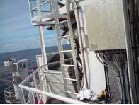Serious injury incident during routine crane maintenance
A member has reported a serious injury incident which took place recently during planned ‘routine’ crane maintenance operations onboard a third party vessel.
Access to the crane cab level was via a stairway from the main deck, leading to a vertical ladder which then gave access to the upper crane platform. At the time of the incident, ‘routine’ planned maintenance was being carried out on the crane winch pumps on the upper crane cab level, as shown below:


The Incident
A crew member was carrying out ‘routine’ maintenance on the upper crane platform, checking gearbox and pump oil levels, of which there were twelve to be checked. The oil check involved manually removing a plug. The crew members’ gloves and boot soles became contaminated with hydraulic oil and, when descending the vertical ladder, the crew member slipped on the ladder rungs and fell approximately two metres to the crane cab platform below. During the fall the crew member’s left leg became trapped in one of the lower rungs, causing injury.
Following immediate assistance from the onboard medic and consultation with medical advisers, the crew member was medevaced ashore. It was later confirmed that the person had suffered a fracture of the left tibia.
Lessons Learnt
Working on the upper crane platform was considered to be a ‘routine’ activity and consequently there were no permit to work (PTW) or other working at height (WAH) controls in place.
There were no task procedures in place for the activity and the method of checking the oil levels by removing a plug to bleed the oil was deemed to be unacceptable. Hazards and controls were not properly identified.
The task was seen purely as ‘routine’ maintenance and there was an unchallenged acceptance of the method of carrying it out.
Perception and awareness of the potential risk involved in this task was low. There was:
- no risk assessment in place;
- no toolbox talk held prior to the job;
- lack of active supervision.
A ladder access survey did not fully recognise the potential risks around safe access/egress from the upper crane platform. The design of the vertical ladder and its location/position was considered to be inadequate and unsuitable:
- ‘Backscratcher’ was considered to be ineffective and did not provide adequate fall protection;
- there was no suitable handrail fitted;
- there was no anti-slip to the ladder rungs;
- the ladder’s position relative to the upper crane platform meant that it was only possible to step on to it in a ‘backwards’ position.
Actions
This incident clearly had the potential for much more serious consequences and was classified as a HIPO (high potential event). The investigation revealed a number of key learning points which should be shared by IMCA member’s to raise awareness and help eliminate any similar incidents in the future.
- ‘routine’ planned maintenance activities should be reviewed to assess if there are any similar ones which may fall under the WAH category and should include a PTW;
- Risk assessments should be in place and be reviewed for ‘routine’ tasks;
- Vessel supervisory staff should actively involve themselves in toolbox talks for marine ‘routine’ activities and ensure that, where appropriate, they are recorded;
- The design and location/position of the existing ladders should be reviewed to ensure/improve safe access/egress.
Safety Event
Published: 22 September 2008
Download: IMCA SF 14/08
IMCA Safety Flashes
Submit a Report
IMCA Safety Flashes summarise key safety matters and incidents, allowing lessons to be more easily learnt for the benefit of all. The effectiveness of the IMCA Safety Flash system depends on Members sharing information and so avoiding repeat incidents. Please consider adding safetyreports@imca-int.com to your internal distribution list for safety alerts or manually submitting information on incidents you consider may be relevant. All information is anonymised or sanitised, as appropriate.
IMCA’s store terms and conditions (https://www.imca-int.com/legal-notices/terms/) apply to all downloads from IMCA’s website, including this document.
IMCA makes every effort to ensure the accuracy and reliability of the data contained in the documents it publishes, but IMCA shall not be liable for any guidance and/or recommendation and/or statement herein contained. The information contained in this document does not fulfil or replace any individual’s or Member's legal, regulatory or other duties or obligations in respect of their operations. Individuals and Members remain solely responsible for the safe, lawful and proper conduct of their operations.
